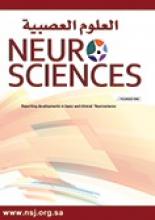Research ArticleOriginal Article
Open Access
Neuroprotective role of thymoquinone against 1-methyl-4-phenylpyridinium-induced dopaminergic cell death in primary mesencephalic cell culture
Khaled S. Radad, Mubarak M. Al-Shraim, Mahmoud F. Moustafa and Wolf-Dieter Rausch
Neurosciences Journal January 2015, 20 (1) 10-16;
Khaled S. Radad
From the Department of Pathology (Radad, Al-Shraim), College of Medicine, the Department of Botany (Moustafa), College of Science, King Khalid University, Abha, Kingdom of Saudi Arabia, the Department of Botany (Moustafa), Faculty of Science, South Valley University, Qena, Egypt, and the Institute of Chemistry and Biochemistry (Rausch), Department for Biomedical Sciences, University for Veterinary Medicine, Vienna, Austria
MVSc, PhDMubarak M. Al-Shraim
From the Department of Pathology (Radad, Al-Shraim), College of Medicine, the Department of Botany (Moustafa), College of Science, King Khalid University, Abha, Kingdom of Saudi Arabia, the Department of Botany (Moustafa), Faculty of Science, South Valley University, Qena, Egypt, and the Institute of Chemistry and Biochemistry (Rausch), Department for Biomedical Sciences, University for Veterinary Medicine, Vienna, Austria
MBBS, FRCPCMahmoud F. Moustafa
From the Department of Pathology (Radad, Al-Shraim), College of Medicine, the Department of Botany (Moustafa), College of Science, King Khalid University, Abha, Kingdom of Saudi Arabia, the Department of Botany (Moustafa), Faculty of Science, South Valley University, Qena, Egypt, and the Institute of Chemistry and Biochemistry (Rausch), Department for Biomedical Sciences, University for Veterinary Medicine, Vienna, Austria
MSc, PhDWolf-Dieter Rausch
From the Department of Pathology (Radad, Al-Shraim), College of Medicine, the Department of Botany (Moustafa), College of Science, King Khalid University, Abha, Kingdom of Saudi Arabia, the Department of Botany (Moustafa), Faculty of Science, South Valley University, Qena, Egypt, and the Institute of Chemistry and Biochemistry (Rausch), Department for Biomedical Sciences, University for Veterinary Medicine, Vienna, Austria
Dipl.-Ing, PhD
References
- ↵
- Harrison IF,
- Dexter DT
- ↵
- Glavaski-Joksimovic A,
- Bohn MC
- ↵
- Utsumi H,
- Okuma Y,
- Kano O,
- Suzuki Y,
- Iijima M,
- Tomimitsu H,
- et al.
- ↵
- Chong CM,
- Zhou ZY,
- Razmovski-Naumovski V,
- Cui GZ,
- Zhang LQ,
- Sa F,
- et al.
- ↵
- Qin RA,
- Yao XX,
- Huang ZY
- ↵
- Hosseinzadeh H,
- Parvardeh S,
- Asl MN,
- Sadeghnia HR,
- Ziaee T
- ↵
- Khan A,
- Vaibhav K,
- Javed H,
- Khan MM,
- Tabassum R,
- Ahmed ME,
- et al.
- ↵
- Kanter M
- ↵
- Radad K,
- Moldzio R,
- Taha M,
- Rausch WD
- ↵
- Radad K,
- Moldzio R,
- Rausch WD
- ↵
- Koh JY,
- Choi DW
- ↵
- Gwag BJ,
- Lobner D,
- Koh JY,
- Wie MB,
- Choi DW
- ↵
- White RJ,
- Reynolds IJ
- ↵
- Storch A,
- Ludolph AC,
- Schwarz J
- ↵
- Kwok KH,
- Ho PW,
- Chu AC,
- Ho JW,
- Liu HF,
- Yiu DC,
- et al.
- ↵
- Xu L,
- Li W,
- Lin D,
- Zhang H,
- Zou F
- ↵
- Nakai M,
- Mori A,
- Watanabe A,
- Mitsumoto Y
- ↵
- Yi F,
- He X,
- Wang D
- ↵
- Tang XQ,
- Li YJ,
- Zhao J,
- Shen XT,
- Yang CT,
- Fan LL,
- et al.
- ↵
- Kost GC,
- Selvaraj S,
- Lee YB,
- Kim DJ,
- Ahn CH,
- Singh BB
- ↵
- He C,
- Klionsky DJ
- ↵
- Ullah I,
- Ullah N,
- Naseer MI,
- Lee HY,
- Kim MO
- ↵
- Alhebshi AH,
- Gotoh M,
- Suzuki I
- ↵
- Zhang X,
- Yan H,
- Yuan Y,
- Gao J,
- Shen Z,
- Cheng Y,
- et al.
In this issue
Neuroprotective role of thymoquinone against 1-methyl-4-phenylpyridinium-induced dopaminergic cell death in primary mesencephalic cell culture
Khaled S. Radad, Mubarak M. Al-Shraim, Mahmoud F. Moustafa, Wolf-Dieter Rausch
Neurosciences Journal Jan 2015, 20 (1) 10-16;
Jump to section
Related Articles
- No related articles found.
Cited By...
- No citing articles found.





